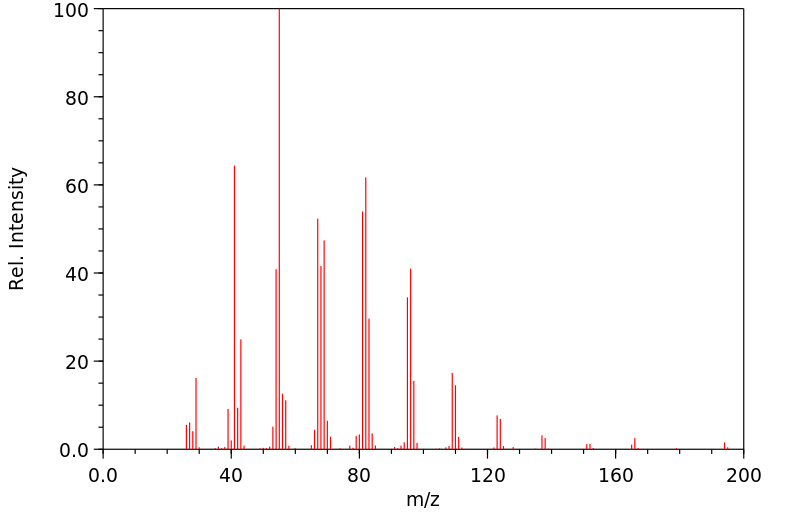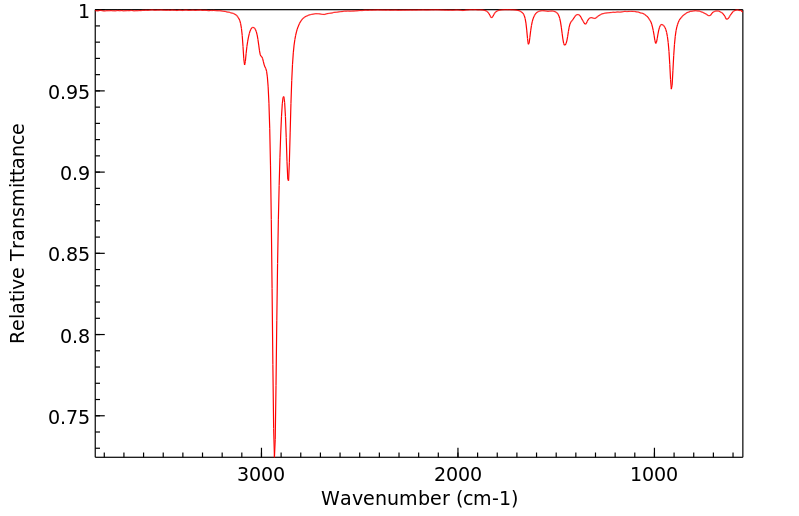(1,13-十四烷二)烯 | 21964-49-8
中文名称
(1,13-十四烷二)烯
中文别名
1,13-十四二烯;1,13-十四烷二烯
英文名称
tetradeca-1,13-diene
英文别名
1,13-tetradecenediene;1,13-tetradecadiene;Tetradeca-1,13-dien;decene-butene;Tetradecadien-(1,13)
CAS
21964-49-8
化学式
C14H26
mdl
MFCD00014941
分子量
194.36
InChiKey
XMRSTLBCBDIKFI-UHFFFAOYSA-N
BEILSTEIN
——
EINECS
——
-
物化性质
-
计算性质
-
ADMET
-
安全信息
-
SDS
-
制备方法与用途
-
上下游信息
-
文献信息
-
表征谱图
-
同类化合物
-
相关功能分类
-
相关结构分类
物化性质
-
沸点:131 °C/17 mmHg (lit.)
-
密度:0.849 g/mL at 25 °C (lit.)
-
闪点:219 °F
-
保留指数:1373;1385;1385;1380
-
稳定性/保质期:
存在于主流烟气中。
计算性质
-
辛醇/水分配系数(LogP):6.8
-
重原子数:14
-
可旋转键数:11
-
环数:0.0
-
sp3杂化的碳原子比例:0.714
-
拓扑面积:0
-
氢给体数:0
-
氢受体数:0
安全信息
-
危险品标志:Xi
-
危险类别码:R36/37/38
-
WGK Germany:3
-
海关编码:2901299090
-
安全说明:S26,S36
-
储存条件:室温
SDS
1.1 产品标识符
: (1,13-十四烷二)烯
产品名称
1.2 鉴别的其他方法
无数据资料
1.3 有关的确定了的物质或混合物的用途和建议不适合的用途
仅供科研用途,不作为药物、家庭备用药或其它用途。
模块 2. 危险性概述
2.1 GHS分类
皮肤刺激 (类别2)
眼刺激 (类别2A)
特异性靶器官系统毒性(一次接触) (类别3)
2.2 GHS 标记要素,包括预防性的陈述
象形图
警示词 警告
危险申明
H315 造成皮肤刺激。
H319 造成严重眼刺激。
H335 可能引起呼吸道刺激。
警告申明
预防
P261 避免吸入粉尘/烟/气体/烟雾/蒸气/喷雾.
P264 操作后彻底清洁皮肤。
P271 只能在室外或通风良好之处使用。
P280 穿戴防护手套/ 眼保护罩/ 面部保护罩。
措施
P302 + P352 如与皮肤接触,用大量肥皂和水冲洗受感染部位.
P304 + P340 如吸入,将患者移至新鲜空气处并保持呼吸顺畅的姿势休息.
P305 + P351 + P338 如与眼睛接触,用水缓慢温和地冲洗几分钟。如戴隐形眼镜并可方便地取
出,取出隐形眼镜,然后继续冲洗.
P312 如感觉不适,呼救中毒控制中心或医生.
P321 具体治疗(见本标签上提供的急救指导)。
P332 + P313 如发生皮肤刺激:求医/ 就诊。
P337 + P313 如仍觉眼睛刺激:求医/就诊。 如仍觉眼睛刺激:求医/就诊.
P362 脱掉沾染的衣服,清洗后方可重新使用。
储存
P403 + P233 存放于通风良的地方。 保持容器密闭。
P405 存放处须加锁。
处理
P501 将内容物/ 容器处理到得到批准的废物处理厂。
2.3 其它危害物 - 无
模块 3. 成分/组成信息
3.1 物 质
: C14H26
分子式
: 194.36 g/mol
分子量
组分 浓度或浓度范围
TetradECa-1,13-diene
-
CAS 号 21964-49-8
EC-编号 244-687-7
模块 4. 急救措施
4.1 必要的急救措施描述
一般的建议
请教医生。 出示此安全技术说明书给到现场的医生看。
吸入
如果吸入,请将患者移到新鲜空气处。 如果停止了呼吸,给于人工呼吸。 请教医生。
皮肤接触
用肥皂和大量的水冲洗。 请教医生。
眼睛接触
用大量水彻底冲洗至少15分钟并请教医生。
食入
切勿给失去知觉者从嘴里喂食任何东西。 用水漱口。 请教医生。
4.2 主要症状和影响,急性和迟发效应
据我们所知,此化学,物理和毒性性质尚未经完整的研究。
4.3 及时的医疗处理和所需的特殊处理的说明和指示
无数据资料
模块 5. 消防措施
5.1 灭火介质
灭火方法及灭火剂
用水雾,耐醇泡沫,干粉或二氧化碳灭火。
5.2 源于此物质或混合物的特别的危害
碳氧化物
5.3 给消防员的建议
如必要的话,戴自给式呼吸器去救火。
5.4 进一步信息
无数据资料
模块 6. 泄露应急处理
6.1 人员的预防,防护设备和紧急处理程序
使用个人防护设备。 防止吸入蒸汽、气雾或气体。 保证充分的通风。 将人员撤离到安全区域。
6.2 环境保护措施
不要让产物进入下水道。
6.3 抑制和清除溢出物的方法和材料
用惰性吸附材料吸收并当作危险废品处理。 存放进适当的闭口容器中待处理。
6.4 参考其他部分
丢弃处理请参阅第13节。
模块 7. 操作处置与储存
7.1 安全操作的注意事项
避免接触皮肤和眼睛。 防止吸入蒸汽和烟雾。
一般性的防火保护措施。
7.2 安全储存的条件,包括任何不兼容性
贮存在阴凉处。 容器保持紧闭,储存在干燥通风处。
打开了的容器必须仔细重新封口并保持竖放位置以防止泄漏。
7.3 特定用途
无数据资料
模块 8. 接触控制和个体防护
8.1 容许浓度
最高容许浓度
没有已知的国家规定的暴露极限。
8.2 暴露控制
适当的技术控制
按照良好工业和安全规范操作。 休息前和工作结束时洗手。
个体防护设备
眼/面保护
带有防护边罩的安全眼镜符合 EN166要求请使用经官方标准如NIOSH (美国) 或 EN 166(欧盟)
检测与批准的设备防护眼部。
皮肤保护
戴手套取 手套在使用前必须受检查。
请使用合适的方法脱除手套(不要接触手套外部表面),避免任何皮肤部位接触此产品.
使用后请将被污染过的手套根据相关法律法规和有效的实验室规章程序谨慎处理. 请清洗并吹干双手
所选择的保护手套必须符合EU的89/686/EEC规定和从它衍生出来的EN 376标准。
身体保护
防渗透的衣服, 防护设备的类型必须根据特定工作场所中的危险物的浓度和含量来选择。
呼吸系统防护
如危险性评测显示需要使用空气净化的防毒面具,请使用全面罩式多功能防毒面具(US)或ABEK型
(EN
14387)防毒面具筒作为工程控制的候补。如果防毒面具是保护的唯一方式,则使用全面罩式送风防
毒面具。 呼吸器使用经过测试并通过政府标准如NIOSH(US)或CEN(EU)的呼吸器和零件。
模块 9. 理化特性
9.1 基本的理化特性的信息
a) 外观与性状
形状: 透明, 液体
颜色: 无色
b) 气味
无数据资料
c) 气味阈值
无数据资料
d) pH值
无数据资料
e) 熔点/凝固点
无数据资料
f) 起始沸点和沸程
131 °C 在 23 hPa - lit.
g) 闪点
103 °C - 闭杯
h) 蒸发速率
无数据资料
i) 易燃性(固体,气体)
无数据资料
j) 高的/低的燃烧性或爆炸性限度 无数据资料
k) 蒸汽压
无数据资料
l) 蒸汽密度
无数据资料
m) 相对密度
0.849 g/cm3 在 25 °C
n) 水溶性
无数据资料
o) n-辛醇/水分配系数
无数据资料
p) 自燃温度
无数据资料
q) 分解温度
无数据资料
r) 粘度
无数据资料
模块 10. 稳定性和反应活性
10.1 反应性
无数据资料
10.2 稳定性
无数据资料
10.3 危险反应的可能性
无数据资料
10.4 应避免的条件
无数据资料
10.5 不兼容的材料
强氧化剂
10.6 危险的分解产物
其它分解产物 - 无数据资料
模块 11. 毒理学资料
11.1 毒理学影响的信息
急性毒性
无数据资料
皮肤刺激或腐蚀
无数据资料
眼睛刺激或腐蚀
无数据资料
呼吸道或皮肤过敏
无数据资料
生殖细胞突变性
无数据资料
致癌性
IARC:
此产品中没有大于或等于 0。1%含量的组分被 IARC鉴别为可能的或肯定的人类致癌物。
生殖毒性
无数据资料
特异性靶器官系统毒性(一次接触)
吸入 - 可能引起呼吸道刺激。
特异性靶器官系统毒性(反复接触)
无数据资料
吸入危险
无数据资料
潜在的健康影响
吸入 吸入可能有害。 引起呼吸道刺激。
摄入 如服入是有害的。
皮肤 如果通过皮肤吸收可能是有害的。 造成皮肤刺激。
眼睛 造成严重眼刺激。
接触后的征兆和症状
据我们所知,此化学,物理和毒性性质尚未经完整的研究。
附加说明
化学物质毒性作用登记: 无数据资料
模块 12. 生态学资料
12.1 生态毒性
无数据资料
12.2 持久存留性和降解性
无数据资料
12.3 潜在的生物蓄积性
无数据资料
12.4 土壤中的迁移性
无数据资料
12.5 PBT 和 vPvB的结果评价
无数据资料
12.6 其它不利的影响
无数据资料
模块 13. 废弃处置
13.1 废物处理方法
产品
将剩余的和未回收的溶液交给处理公司。 联系专业的拥有废弃物处理执照的机构来处理此物质。
受污染的容器和包装
作为未用过的产品弃置。
模块 14. 运输信息
14.1 联合国危险货物编号
欧洲陆运危规: - 国际海运危规: - 国际空运危规: -
14.2 联合国(UN)规定的名称
欧洲陆运危规: 非危险货物
国际海运危规: 非危险货物
国际空运危规: 非危险货物
14.3 运输危险类别
欧洲陆运危规: - 国际海运危规: - 国际空运危规: -
14.4 包裹组
欧洲陆运危规: - 国际海运危规: - 国际空运危规: -
14.5 环境危险
欧洲陆运危规: 否 国际海运危规 海运污染物: 否 国际空运危规: 否
14.6 对使用者的特别提醒
无数据资料
模块 15 - 法规信息
N/A
模块16 - 其他信息
N/A
: (1,13-十四烷二)烯
产品名称
1.2 鉴别的其他方法
无数据资料
1.3 有关的确定了的物质或混合物的用途和建议不适合的用途
仅供科研用途,不作为药物、家庭备用药或其它用途。
模块 2. 危险性概述
2.1 GHS分类
皮肤刺激 (类别2)
眼刺激 (类别2A)
特异性靶器官系统毒性(一次接触) (类别3)
2.2 GHS 标记要素,包括预防性的陈述
象形图
警示词 警告
危险申明
H315 造成皮肤刺激。
H319 造成严重眼刺激。
H335 可能引起呼吸道刺激。
警告申明
预防
P261 避免吸入粉尘/烟/气体/烟雾/蒸气/喷雾.
P264 操作后彻底清洁皮肤。
P271 只能在室外或通风良好之处使用。
P280 穿戴防护手套/ 眼保护罩/ 面部保护罩。
措施
P302 + P352 如与皮肤接触,用大量肥皂和水冲洗受感染部位.
P304 + P340 如吸入,将患者移至新鲜空气处并保持呼吸顺畅的姿势休息.
P305 + P351 + P338 如与眼睛接触,用水缓慢温和地冲洗几分钟。如戴隐形眼镜并可方便地取
出,取出隐形眼镜,然后继续冲洗.
P312 如感觉不适,呼救中毒控制中心或医生.
P321 具体治疗(见本标签上提供的急救指导)。
P332 + P313 如发生皮肤刺激:求医/ 就诊。
P337 + P313 如仍觉眼睛刺激:求医/就诊。 如仍觉眼睛刺激:求医/就诊.
P362 脱掉沾染的衣服,清洗后方可重新使用。
储存
P403 + P233 存放于通风良的地方。 保持容器密闭。
P405 存放处须加锁。
处理
P501 将内容物/ 容器处理到得到批准的废物处理厂。
2.3 其它危害物 - 无
模块 3. 成分/组成信息
3.1 物 质
: C14H26
分子式
: 194.36 g/mol
分子量
组分 浓度或浓度范围
TetradECa-1,13-diene
-
CAS 号 21964-49-8
EC-编号 244-687-7
模块 4. 急救措施
4.1 必要的急救措施描述
一般的建议
请教医生。 出示此安全技术说明书给到现场的医生看。
吸入
如果吸入,请将患者移到新鲜空气处。 如果停止了呼吸,给于人工呼吸。 请教医生。
皮肤接触
用肥皂和大量的水冲洗。 请教医生。
眼睛接触
用大量水彻底冲洗至少15分钟并请教医生。
食入
切勿给失去知觉者从嘴里喂食任何东西。 用水漱口。 请教医生。
4.2 主要症状和影响,急性和迟发效应
据我们所知,此化学,物理和毒性性质尚未经完整的研究。
4.3 及时的医疗处理和所需的特殊处理的说明和指示
无数据资料
模块 5. 消防措施
5.1 灭火介质
灭火方法及灭火剂
用水雾,耐醇泡沫,干粉或二氧化碳灭火。
5.2 源于此物质或混合物的特别的危害
碳氧化物
5.3 给消防员的建议
如必要的话,戴自给式呼吸器去救火。
5.4 进一步信息
无数据资料
模块 6. 泄露应急处理
6.1 人员的预防,防护设备和紧急处理程序
使用个人防护设备。 防止吸入蒸汽、气雾或气体。 保证充分的通风。 将人员撤离到安全区域。
6.2 环境保护措施
不要让产物进入下水道。
6.3 抑制和清除溢出物的方法和材料
用惰性吸附材料吸收并当作危险废品处理。 存放进适当的闭口容器中待处理。
6.4 参考其他部分
丢弃处理请参阅第13节。
模块 7. 操作处置与储存
7.1 安全操作的注意事项
避免接触皮肤和眼睛。 防止吸入蒸汽和烟雾。
一般性的防火保护措施。
7.2 安全储存的条件,包括任何不兼容性
贮存在阴凉处。 容器保持紧闭,储存在干燥通风处。
打开了的容器必须仔细重新封口并保持竖放位置以防止泄漏。
7.3 特定用途
无数据资料
模块 8. 接触控制和个体防护
8.1 容许浓度
最高容许浓度
没有已知的国家规定的暴露极限。
8.2 暴露控制
适当的技术控制
按照良好工业和安全规范操作。 休息前和工作结束时洗手。
个体防护设备
眼/面保护
带有防护边罩的安全眼镜符合 EN166要求请使用经官方标准如NIOSH (美国) 或 EN 166(欧盟)
检测与批准的设备防护眼部。
皮肤保护
戴手套取 手套在使用前必须受检查。
请使用合适的方法脱除手套(不要接触手套外部表面),避免任何皮肤部位接触此产品.
使用后请将被污染过的手套根据相关法律法规和有效的实验室规章程序谨慎处理. 请清洗并吹干双手
所选择的保护手套必须符合EU的89/686/EEC规定和从它衍生出来的EN 376标准。
身体保护
防渗透的衣服, 防护设备的类型必须根据特定工作场所中的危险物的浓度和含量来选择。
呼吸系统防护
如危险性评测显示需要使用空气净化的防毒面具,请使用全面罩式多功能防毒面具(US)或ABEK型
(EN
14387)防毒面具筒作为工程控制的候补。如果防毒面具是保护的唯一方式,则使用全面罩式送风防
毒面具。 呼吸器使用经过测试并通过政府标准如NIOSH(US)或CEN(EU)的呼吸器和零件。
模块 9. 理化特性
9.1 基本的理化特性的信息
a) 外观与性状
形状: 透明, 液体
颜色: 无色
b) 气味
无数据资料
c) 气味阈值
无数据资料
d) pH值
无数据资料
e) 熔点/凝固点
无数据资料
f) 起始沸点和沸程
131 °C 在 23 hPa - lit.
g) 闪点
103 °C - 闭杯
h) 蒸发速率
无数据资料
i) 易燃性(固体,气体)
无数据资料
j) 高的/低的燃烧性或爆炸性限度 无数据资料
k) 蒸汽压
无数据资料
l) 蒸汽密度
无数据资料
m) 相对密度
0.849 g/cm3 在 25 °C
n) 水溶性
无数据资料
o) n-辛醇/水分配系数
无数据资料
p) 自燃温度
无数据资料
q) 分解温度
无数据资料
r) 粘度
无数据资料
模块 10. 稳定性和反应活性
10.1 反应性
无数据资料
10.2 稳定性
无数据资料
10.3 危险反应的可能性
无数据资料
10.4 应避免的条件
无数据资料
10.5 不兼容的材料
强氧化剂
10.6 危险的分解产物
其它分解产物 - 无数据资料
模块 11. 毒理学资料
11.1 毒理学影响的信息
急性毒性
无数据资料
皮肤刺激或腐蚀
无数据资料
眼睛刺激或腐蚀
无数据资料
呼吸道或皮肤过敏
无数据资料
生殖细胞突变性
无数据资料
致癌性
IARC:
此产品中没有大于或等于 0。1%含量的组分被 IARC鉴别为可能的或肯定的人类致癌物。
生殖毒性
无数据资料
特异性靶器官系统毒性(一次接触)
吸入 - 可能引起呼吸道刺激。
特异性靶器官系统毒性(反复接触)
无数据资料
吸入危险
无数据资料
潜在的健康影响
吸入 吸入可能有害。 引起呼吸道刺激。
摄入 如服入是有害的。
皮肤 如果通过皮肤吸收可能是有害的。 造成皮肤刺激。
眼睛 造成严重眼刺激。
接触后的征兆和症状
据我们所知,此化学,物理和毒性性质尚未经完整的研究。
附加说明
化学物质毒性作用登记: 无数据资料
模块 12. 生态学资料
12.1 生态毒性
无数据资料
12.2 持久存留性和降解性
无数据资料
12.3 潜在的生物蓄积性
无数据资料
12.4 土壤中的迁移性
无数据资料
12.5 PBT 和 vPvB的结果评价
无数据资料
12.6 其它不利的影响
无数据资料
模块 13. 废弃处置
13.1 废物处理方法
产品
将剩余的和未回收的溶液交给处理公司。 联系专业的拥有废弃物处理执照的机构来处理此物质。
受污染的容器和包装
作为未用过的产品弃置。
模块 14. 运输信息
14.1 联合国危险货物编号
欧洲陆运危规: - 国际海运危规: - 国际空运危规: -
14.2 联合国(UN)规定的名称
欧洲陆运危规: 非危险货物
国际海运危规: 非危险货物
国际空运危规: 非危险货物
14.3 运输危险类别
欧洲陆运危规: - 国际海运危规: - 国际空运危规: -
14.4 包裹组
欧洲陆运危规: - 国际海运危规: - 国际空运危规: -
14.5 环境危险
欧洲陆运危规: 否 国际海运危规 海运污染物: 否 国际空运危规: 否
14.6 对使用者的特别提醒
无数据资料
模块 15 - 法规信息
N/A
模块16 - 其他信息
N/A
上下游信息
-
上游原料
中文名称 英文名称 CAS号 化学式 分子量 环十二烯 cyclododecene 1501-82-2 C12H22 166.307 1-己烯 1-hexene 592-41-6 C6H12 84.1613 (10R)-10-甲基-1-十三碳烯 (10R)-10-methyl-1-tridecene 82621-68-9 C14H28 196.376 7-溴-1-庚烯 7-bromo-hept-1-ene 4117-09-3 C7H13Br 177.084 -
下游产品
中文名称 英文名称 CAS号 化学式 分子量 (Z)-1,12-十七碳二烯 (Z)-5,16-heptadecadiene 81500-71-2 C17H32 236.441 14-溴-1-十四碳烯 14-bromo-1-tetradecene 74646-31-4 C14H27Br 275.272 —— Δ12-tetradecenol 129189-60-2 C14H28O 212.376 3,13-十八碳二烯-1-醇 (3Z,13Z)-3,13-octadecadienyl alcohol 66410-24-0 C18H34O 266.467
反应信息
-
作为反应物:描述:参考文献:名称:产乙酸原蛋白的线性氮杂和硫代类似物的合成及其细胞毒性的评价摘要:根据一般的合成路线,合成了四无氮产乙酸甘油酯的四个氮杂和两个硫代类似物。通过末端双环氧化物的水解动力学拆分,一步一步将类似物中的两个远程立体中心设置为具有高对映体和非对映体选择性。DOI:10.1002/ejoc.201300767
-
作为产物:描述:十六碳二酸 在 formate dehydrogenase 、 1200 U catalase 、 OleT in combination with the putidaredoxin electron-transfer system CamAB 、 P450 monooxygenase OleT 、 甲酸铵 、 NADH 作用下, 以 二甲基亚砜 为溶剂, 反应 72.0h, 生成 (1,13-十四烷二)烯参考文献:名称:二元酸的酶促氧化串联脱羧成末端二烯摘要:C7-C18 二元羧酸到末端 C5-C16 二烯的生物催化氧化串联脱羧由 P450 单加氧酶 OleT 催化,1,11-十二二烯(0.49 g L-1)的转化率高达 29%。中间体 C6-C11 ω-链烯酸和庚二酸的脱羧反应仅生成非共轭 1,4-戊二烯,证明了级联的顺序性质;放大允许分离 1,15-十六二烯和 1,11-十二二烯;该系统代表了一条从可再生二元羧酸获得末端二烯的绿色短途路线。DOI:10.1002/ejoc.201600358
文献信息
-
A Photoirradiative Phase-Vanishing Method: Efficient Generation of HBr from Alkanes and Molecular Bromine and Its Use for Subsequent Radical Addition to Terminal Alkenes作者:Hiroshi Matsubara、Ilhyong Ryu、Masaaki Tsukida、Daisuke Ishihara、Kenji KuniyoshiDOI:10.1055/s-0030-1258482日期:2010.8phase-vanishing (PV) system comprised of an alkane, perfluorohexanes, and bromine was successfully combined by photoirradiation to efficiently generate hydrogen bromide, which underwent radical addition with 1-alkenes in the hydrocarbon layer to afford terminal bromides in high yields.
-
Monocatenary, branched, double-headed, and bolaform surface active carbohydrate esters via photochemical thiol-ene/-yne reactions作者:Cédric Boyère、Guy Broze、Christophe Blecker、Christine Jérôme、Antoine DebuigneDOI:10.1016/j.carres.2013.07.003日期:2013.10amphiphilic carbohydrate esters, respectively. A surface activity study showed that these new compounds possess valuable properties and display specific behavior at the air-water interface. It also demonstrated the greater flexibility of the thioether moiety in the spacer of the surfactants produced via a thiol-ene reaction in comparison with the triazole heterocyclic rings in similar glucose-based surfactants
-
Synthesis of Naturally Occurring Pyridine Alkaloids via Palladium-Catalyzed Coupling/Migration Chemistry作者:Yao Wang、Xiaoyang Dong、Richard C. LarockDOI:10.1021/jo026716p日期:2003.4.1The palladium-catalyzed cross-coupling of 3-iodopyridine, long-chain terminal dienes, and benzylic amines or tosylamides provides a novel route to key intermediates for the synthesis of the naturally occurring, biologically active pyridine alkaloids theonelladins C and D, niphatesine C, and xestamine D. This process involves (1) oxidative addition of the heterocyclic iodide to Pd(0), (2) carbopalladation
-
A novel hydrogen transfer hydroalumination of alkenes with triisobutylaluminum catalyzed by Pd and other late transition metal complexes作者:Sebastien Gagneur、Hidefumi Makabe、Ei-ichi NegishiDOI:10.1016/s0040-4039(00)02142-0日期:2001.1Hydrogen transfer hydroalumination of terminal alkenes and dienes can be achieved with 1.1 equiv. of (i-Bu)3Al and catalytic amounts of Cl2Pd(PPh3)2 and other late transition metal complexes containing Co, Rh, Ni, and Pt at ambient temperature in high yields.末端烯烃和二烯的氢转移加氢铝化反应可以达到1.1当量。(i- Bu)3 Al在室温下的催化产率高,且催化量的Cl 2 Pd(PPh 3)2和其他含Co,Rh,Ni和Pt的后期过渡金属配合物。
-
Syntheses and Palladium, Platinum, and Borane Adducts of Symmetrical Trialkylphosphines with Three Terminal Vinyl Groups, P((CH<sub>2</sub>)<sub>m</sub>CH=CH<sub>2</sub>)<sub>3</sub>作者:Agnieszka J. Nawara-Hultzsch、Katrin Skopek、Takanori Shima、Michał Barbasiewicz、Gisela D Hess、Dirk Skaper、John A GladyszDOI:10.1515/znb-2010-0327日期:2010.3.1
Reactions of Br(CH2)mCH=CH2 with Mg powder and then PCl3 (0.33 equiv.) afford P((CH2)m- CH=CH2)3 (1; m = a, 4; b, 5; c, 6; d, 7; e, 8; f, 9; 52 - 87%). Reactions of 1a - c, e with PdX2(COD) (X = Cl, Br) give trans-PdX2(P((CH2)mCH=CH2)3)2 (35 - 92%). Reactions of 1b - e with PtCl2 in benzene give mainly trans-PtCl2(P((CH2)mCH=CH2)3)2 (trans-5b-e; 52 - 75%), whereas those with K2PtCl4 in water give mainly cis-5b-e (33 - 70%). The reaction of equimolar quantities of 1c and H3B・S(CH3)2 gives the 1 : 1 adduct H3B・P((CH2)6CH=CH2)3 (85%). In none of these transformations are by-products derived from the C=C linkages observed
Br(CH₂)ₘCH=CH₂与镁粉和PCl₃(0.33当量)的反应得到P((CH₂)ₘ- CH=CH₂)₃(1; m = a, 4; b, 5; c, 6; d, 7; e, 8; f, 9; 52 - 87%)。1a - c, e与PdX₂(COD)(X = Cl, Br)反应得到反式-PdX₂(P((CH₂)ₘCH=CH₂)₃)₂(35 - 92%)。1b - e与PtCl₂在苯中反应主要得到反式-PtCl₂(P((CH₂)ₘCH=CH₂)₃)₂(反-5b-e; 52 - 75%),而与K₂PtCl₄在水中反应主要得到顺式-5b-e(33 - 70%)。1c和H₃B・S(CH₃)₂等量反应得到1:1加合物H₃B・P((CH₂)₆CH=CH₂)₃(85%)。在这些转化中,没有观察到来自C=C键的副产物。
表征谱图
-
氢谱1HNMR
-
质谱MS
-
碳谱13CNMR
-
红外IR
-
拉曼Raman
-
峰位数据
-
峰位匹配
-
表征信息
同类化合物
高密聚乙烯
香叶醇
顺式3-甲基-2-己烯
顺式-5-癸烯
顺式-5-甲基-2-己烯
顺式-5-庚烯-1-炔
顺式-4-癸烷
顺式-4-甲基-2-戊烯
顺式-4-甲基-2-戊烯
顺式-3-癸烯
顺式-3-甲基-3-己烯
顺式-3-甲基-2-庚烯
顺式-3-戊烯-1-炔
顺式-3,4-二甲基-3-己烯
顺式-3,4-二甲基-2-戊烯
顺式-3,4-二甲基-2-戊烯
顺式-2-甲基-3-己烯
顺式-2-壬烯
顺式-2-丁烯-D1
顺式-1.1.1-三甲基-2-丁烯
顺式-1-甲基-2-环丙基乙烯
顺式-1-甲基-2-乙烯基环戊烷
顺式-1-环戊基-1-辛烯
顺式-1-氘代-3-甲基-1-丁烯
顺式-(9ci)-2,3,3a,7a-四氢-4-(1-甲基乙基)-1H-茚
顺式-(2-丁烯基)环丙烷
顺式,顺式-2,4-己二烯
顺-环辛烯
顺-9-二十一碳烯
顺-6-十三碳烯
顺-5-甲基-1,3,6-庚三烯
顺-4-辛烯
顺-4-壬烯
顺-3-辛烯
顺-3-甲基-2-戊烯
顺-3-壬烯
顺-3-十三碳烯
顺-2-辛烯
顺-2-癸烯
顺-2-戊烯
顺-2-庚烯
顺-2-己烯
顺-2-丁烯
顺-2,2-二甲基-3-己烯
顺-1,3-戊二烯
顺,顺-1,9-环十六烷二烯
顺,顺,顺-环癸-1,3,5-三烯
间戊二烯
间二(4-吡啶基)苯
镁,二-2-丁烯基-








